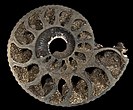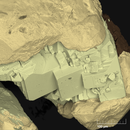Pyrite
| Pyrite | |
|---|---|
 Intergrowth of lustrous, cubic crystals of pyrite, with some surfaces showing characteristic striations, from Huanzala mine, Ancash, Peru. Specimen size: 7.0 × 5.0 × 2.5 cm | |
| General | |
| Category | Sulfide mineral |
| Formula (repeating unit) | FeS |
| IMA symbol | Py[1] |
| Strunz classification | 2.EB.05a |
| Dana classification | 2.12.1.1 |
| Crystal system | Cubic |
| Crystal class | Diploidal (m3) H-M symbol:(2/m3) |
| Space group | Pa3 |
| Unit cell | a = 5.417Å,Z = 4 |
| Identification | |
| Formula mass | 119.98 g/mol |
| Color | Pale brass-yellow reflective; tarnishes darker and iridescent |
| Crystal habit | Cubic, faces may be striated, but also frequently octahedral and pyritohedral. Often inter-grown, massive, radiated, granular, globular, and stalactitic. |
| Twinning | Penetration and contact twinning |
| Cleavage | Indistinct on {001}; partings on {011} and {111} |
| Fracture | Very uneven, sometimes conchoidal |
| Tenacity | Brittle |
| Mohs scalehardness | 6–6.5 |
| Luster | Metallic, glistening |
| Streak | Greenish-black to brownish-black |
| Diaphaneity | Opaque |
| Specific gravity | 4.95–5.10 |
| Density | 4.8–5 g/cm3 |
| Fusibility | 2.5–3 to a magnetic globule |
| Solubility | Insoluble in water |
| Other characteristics | paramagnetic |
| References | [2][3][4][5] |
Themineralpyrite(/ˈpaɪraɪt/PY-ryte),[6]oriron pyrite,also known asfool's gold,is aniron sulfidewith thechemical formulaFeS2(iron (II) disulfide). Pyrite is the most abundantsulfide mineral.[7]
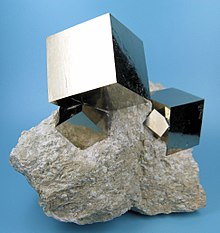
Pyrite's metalliclusterand pale brass-yellowhuegive it a superficial resemblance togold,hence the well-known nickname offool's gold.The color has also led to the nicknamesbrass,brazzle,andbrazil,primarily used to refer to pyrite found incoal.[8][9]
The namepyriteis derived from theGreekπυρίτης λίθος(pyritēs lithos), 'stone or mineral which strikes fire',[10]in turn fromπῦρ(pŷr), 'fire'.[11]In ancient Roman times, this name was applied to several types of stone that would create sparks when struck againststeel;Pliny the Elderdescribed one of them as being brassy, almost certainly a reference to what is now called pyrite.[12]
ByGeorgius Agricola's time,c. 1550,the term had become a generic term for all of thesulfide minerals.[13]

Pyrite is usually found associated with other sulfides oroxidesinquartzveins,sedimentary rock,andmetamorphic rock,as well as in coal beds and as a replacement mineral infossils,but has also been identified in thescleritesofscaly-foot gastropods.[14]Despite being nicknamed "fool's gold", pyrite is sometimes found in association with small quantities of gold. A substantial proportion of the gold is "invisible gold" incorporated into the pyrite (seeCarlin-type gold deposit). It has been suggested that the presence of both gold andarsenicis a case ofcoupled substitutionbut as of 1997 the chemical state of the gold remained controversial.[15]
Uses
[edit]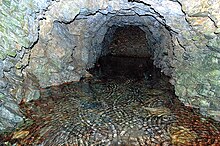
Pyrite gained a brief popularity in the 16th and 17th centuries as a source ofignitionin earlyfirearms,most notably thewheellock,where a sample of pyrite was placed against a circular file to strike the sparks needed to fire the gun.[16]
Pyrite is used withflintstoneand a form oftindermade ofstringybarkby theKaurna peopleofSouth Australia,as a traditional method of starting fires.[17]
Pyrite has been used since classical times to manufacturecopperas(ferrous sulfate). Iron pyrite was heaped up and allowed to weather (an example of an early form ofheap leaching). The acidic runoff from the heap was then boiled with iron to produce iron sulfate. In the 15th century, new methods of such leaching began to replace the burning of sulfur as a source ofsulfuric acid.By the 19th century, it had become the dominant method.[18]
Pyrite remains in commercial use for the production ofsulfur dioxide,for use in such applications as thepaper industry,and in the manufacture of sulfuric acid. Thermal decomposition of pyrite into FeS (iron(II) sulfide) and elemental sulfur starts at 540 °C (1,004 °F); at around 700 °C (1,292 °F),pS2is about1 atm.[19]
A newer commercial use for pyrite is as thecathodematerial inEnergizerbrand non-rechargeablelithium metal batteries.[20]
Pyrite is asemiconductor materialwith aband gapof 0.95eV.[21]Pure pyrite is naturally n-type, in both crystal and thin-film forms, potentially due to sulfur vacancies in the pyrite crystal structure acting as n-dopants.[22]
During the early years of the 20th century, pyrite was used as amineral detectorinradioreceivers, and is still used bycrystal radiohobbyists. Until thevacuum tubematured, the crystal detector was the most sensitive and dependabledetectoravailable—with considerable variation between mineral types and even individual samples within a particular type of mineral. Pyrite detectors occupied a midway point betweengalenadetectors and the more mechanically complicatedperikonmineral pairs. Pyrite detectors can be as sensitive as a modern 1N34Agermaniumdiodedetector.[23][24]
Pyrite has been proposed as an abundant, non-toxic, inexpensive material in low-costphotovoltaicsolar panels.[25]Synthetic iron sulfide was used withcopper sulfideto create the photovoltaic material.[26]More recent efforts are working toward thin-film solar cells made entirely of pyrite.[22]
Pyrite is used to makemarcasite jewelry.Marcasite jewelry, using small faceted pieces of pyrite, often set insilver,has been made since ancient times and was popular in theVictorian era.[27]At the time when the term became common in jewelry making, "marcasite" referred to all iron sulfides including pyrite, and not to the orthorhombic FeS2mineralmarcasitewhich is lighter in color, brittle and chemically unstable, and thus not suitable for jewelry making.Marcasite jewelrydoes not actually contain the mineral marcasite. The specimens of pyrite, when it appears as good quality crystals, are used in decoration. They are also very popular in mineral collecting. Among the sites that provide the best specimens areSoriaandLa Riojaprovinces (Spain).[28]
In value terms,China($47 million) constitutes the largest market for imported unroasted iron pyrites worldwide, making up 65% of global imports. China is also the fastest growing in terms of the unroasted iron pyrites imports, with aCAGRof +27.8% from 2007 to 2016.[29]
Research
[edit]In July 2020 scientists reported that they have observed a voltage-induced transformation of normallydiamagneticpyrite into aferromagneticmaterial, which may lead to applications in devices such as solar cells or magnetic data storage.[30][31]
Researchers atTrinity College Dublin,Ireland have demonstrated that FeS2can be exfoliated into few-layers just like other two-dimensional layered materials such as graphene by a simple liquid-phase exfoliation route. This is the first study to demonstrate the production of non-layered 2D-platelets from 3D bulk FeS2.Furthermore, they have used these 2D-platelets with 20% single walled carbon-nanotube as an anode material in lithium-ion batteries, reaching a capacity of 1000 mAh/g close to the theoretical capacity of FeS2.[32]
In 2021, a natural pyrite stone has been crushed and pre-treated followed by liquid-phase exfoliation into two-dimensional nanosheets, which has shown capacities of 1200 mAh/g as an anode in lithium-ion batteries.[33]
Formal oxidation states for pyrite, marcasite, molybdenite and arsenopyrite
[edit]From the perspective of classicalinorganic chemistry,which assigns formal oxidation states to each atom, pyrite and marcasite are probably best described as Fe2+[S2]2−.This formalism recognizes that the sulfur atoms in pyrite occur in pairs with clear S–S bonds. Thesepersulfide[–S–S–] units can be viewed as derived fromhydrogen disulfide,H2S2.Thus pyrite would be more descriptively called iron persulfide, not iron disulfide. In contrast,molybdenite,MoS2,features isolated sulfide S2−centers and the oxidation state of molybdenum is Mo4+.The mineralarsenopyritehas the formula FeAsS. Whereas pyrite has [S2]2–units, arsenopyrite has [AsS]3–units, formally derived fromdeprotonationof arsenothiol (H2AsSH). Analysis of classical oxidation states would recommend the description of arsenopyrite as Fe3+[AsS]3−.[34]
Crystallography
[edit]
Iron-pyrite FeS2represents the prototype compound of thecrystallographicpyrite structure. The structure iscubicand was among the firstcrystal structuressolved byX-ray diffraction.[35]It belongs to the crystallographicspace groupPa3and is denoted by theStrukturberichtnotation C2. Under thermodynamic standard conditions thelattice constantof stoichiometric iron pyrite FeS2amounts to541.87 pm.[36]Theunit cellis composed of a Feface-centered cubic sublatticeinto which theS
2ions are embedded. (Note though that the iron atoms in the faces are not equivalent by translation alone to the iron atoms at the corners.) The pyrite structure is also seen in otherMX2compounds oftransition metalsMandchalcogensX=O,S,SeandTe.CertaindipnictideswithXstanding forP,AsandSbetc. are also known to adopt the pyrite structure.[37]
The Fe atoms are bonded to six S atoms, giving a distorted octahedron. The material is asemiconductor.The Fe ions is usually considered to below spindivalentstate (as shown byMössbauer spectroscopyas well as XPS). The material as a whole behaves as a Van Vleckparamagnet,despite its low-spin divalency.[38]
The sulfur centers occur in pairs, described as S22−.[39]Reduction of pyrite with potassium givespotassium dithioferrate,KFeS2.This material features ferric ions and isolated sulfide (S2-) centers.
The S atoms are tetrahedral, being bonded to three Fe centers and one other S atom. The site symmetry at Fe and S positions is accounted for bypoint symmetry groupsC3iandC3,respectively. The missingcenter of inversionat S lattice sites has important consequences for the crystallographic and physical properties of iron pyrite. These consequences derive from the crystal electric field active at the sulfur lattice site, which causes apolarizationof S ions in the pyrite lattice.[40]The polarisation can be calculated on the basis of higher-orderMadelung constantsand has to be included in the calculation of thelattice energyby using a generalisedBorn–Haber cycle.This reflects the fact that the covalent bond in the sulfur pair is inadequately accounted for by a strictly ionic treatment.[41]
Arsenopyrite has a related structure with heteroatomic As–S pairs rather than S-S pairs. Marcasite also possesses homoatomic anion pairs, but the arrangement of the metal and diatomic anions differ from that of pyrite. Despite its name, chalcopyrite (CuFeS
2) does not contain dianion pairs, but single S2−sulfide anions.
Crystal habit
[edit]
Pyrite usually forms cuboid crystals, sometimes forming in close association to form raspberry-shaped masses calledframboids.However, under certain circumstances, it can formanastomosingfilaments or T-shaped crystals.[42] Pyrite can also form shapes almost the same as a regulardodecahedron,known as pyritohedra, and this suggests an explanation for the artificial geometrical models found in Europe as early as the 5th century BC.[43][clarification needed]
Varieties
[edit]Cattierite(CoS2),vaesite(NiS2) andhauerite(MnS2), as well assperrylite(PtAs2) are similar in their structure and belong also to the pyrite group.
Bravoiteis a nickel-cobalt bearing variety of pyrite, with > 50% substitution ofNi2+for Fe2+within pyrite. Bravoite is not a formally recognised mineral, and is named after the Peruvian scientist Jose J. Bravo (1874–1928).[44]
Distinguishing similar minerals
[edit]Pyrite is distinguishable fromnative goldby its hardness, brittleness and crystal form. Pyrite fractures are veryuneven,sometimesconchoidalbecause it does not cleave along a preferential plane. Nativegold nuggets,or glitters, do not break but deform in aductileway. Pyrite is brittle, gold is malleable.
Natural gold tends to beanhedral(irregularly shaped without well defined faces), whereas pyrite comes as either cubes or multifaceted crystals with well developed and sharp faces easy to recognise. Well crystallised pyrite crystals areeuhedral(i.e.,with nice faces). Pyrite can often be distinguished by the striations which, in many cases, can be seen on its surface.Chalcopyrite(CuFeS2) is brighter yellow with a greenish hue when wet and is softer (3.5–4 on Mohs' scale).[45]Arsenopyrite(FeAsS) is silver white and does not become more yellow when wet.
Hazards
[edit]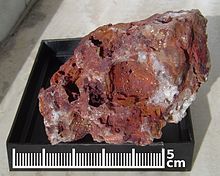
Iron pyrite is unstable when exposed to theoxidizingconditions prevailing at the Earth's surface: iron pyrite in contact with atmosphericoxygenand water, or damp, ultimately decomposes intoiron oxyhydroxides(ferrihydrite,FeO(OH)) andsulfuric acid(H
2SO
4). This process is accelerated by the action ofAcidithiobacillusbacteria which oxidize pyrite to first produceferrous ions(Fe2+
),sulfateions (SO2−
4), and release protons ( H+,orH3O+). In a second step, the ferrous ions (Fe2+
) are oxidized byO2intoferric ions(Fe3+
) whichhydrolyzealso releasing H+ions and producing FeO(OH). These oxidation reactions occur more rapidly when pyrite is finely dispersed (framboidal crystals initially formed bysulfate reducing bacteria(SRB) in argillaceous sediments or dust from mining operations).
Pyrite oxidation and acid mine drainage
[edit]Pyrite oxidation by atmosphericO2in the presence of moisture (H2O) initially produces ferrous ions (Fe2+
) andsulfuric acidwhich dissociates intosulfateions andprotons,leading toacid mine drainage(AMD). An example of acid rock drainage caused by pyrite is the2015 Gold King Mine waste water spill.
- .[46]
Dust explosions
[edit]Pyrite oxidation is sufficientlyexothermicthat undergroundcoal minesin high-sulfur coal seams have occasionally had serious problems withspontaneous combustion.[47]The solution is the use of buffer blasting and the use of various sealing or cladding agents tohermetically sealthe mined-out areas to exclude oxygen.[48]
In modern coal mines,limestonedust is sprayed onto the exposed coal surfaces to reduce the hazard ofdust explosions.This has the secondary benefit of neutralizing the acid released by pyrite oxidation and therefore slowing the oxidation cycle described above, thus reducing the likelihood of spontaneous combustion. In the long term, however, oxidation continues, and thehydratedsulfatesformed may exert crystallization pressure that can expand cracks in the rock and lead eventually toroof fall.[49]
Weakened building materials
[edit]Building stone containing pyrite tends to stain brown as pyrite oxidizes. This problem appears to be significantly worse if anymarcasiteis present.[50]The presence of pyrite in theaggregateused to makeconcretecan lead to severe deterioration as pyrite oxidizes.[51]In early 2009, problems withChinese drywallimported into theUnited StatesafterHurricane Katrinawere attributed to pyrite oxidation, followed by microbial sulfate reduction which releasedhydrogen sulfidegas (H2S). These problems included a foul odor andcorrosionofcopperwiring.[52]In the United States, in Canada,[53]and more recently in Ireland,[54][55][56]where it was used as underfloor infill, pyrite contamination has caused major structural damage.Concreteexposed to sulfate ions, or sulfuric acid, degrades bysulfate attack:the formation of expansive mineral phases, such asettringite(small needle crystals exerting a huge crystallization pressure inside the concrete pores) andgypsumcreates innertensile forcesin the concrete matrix which destroy the hardenedcementpaste, form cracks and fissures in concrete, and can lead to the ultimate ruin of the structure. Normalized tests forconstruction aggregate[57]certify such materials as free of pyrite or marcasite.
Occurrence
[edit]Pyrite is the most common of sulfide minerals and is widespread in igneous, metamorphic, and sedimentary rocks. It is a common accessory mineral in igneous rocks, where it also occasionally occurs as larger masses arising from animmisciblesulfide phase in the original magma. It is found in metamorphic rocks as a product ofcontact metamorphism.It also forms as a high-temperaturehydrothermal mineral,though it occasionally forms at lower temperatures.[2]
Pyrite occurs both as a primary mineral, present in the original sediments, and as a secondary mineral, deposited duringdiagenesis.[2]Pyrite andmarcasitecommonly occur as replacementpseudomorphsafterfossilsinblack shaleand othersedimentary rocksformed underreducingenvironmental conditions.[58]Pyrite is common as an accessory mineral in shale, where it is formed by precipitation from anoxic seawater, and coal beds often contain significant pyrite.[59]
Notable deposits are found as lenticular masses in Virginia, U.S., and in smaller quantities in many other locations. Large deposits are mined at Rio Tinto in Spain and elsewhere in the Iberian Peninsula.[60]
Cultural beliefs
[edit]In the beliefs of the Thai people (especially those in the south), pyrite is known asKhao tokPhra Ruang,Khao khon bat Phra Ruang(ข้าวตอกพระร่วง, ข้าวก้นบาตรพระร่วง) orPhet na tang,Hin na tang(เพชรหน้าทั่ง, หินหน้าทั่ง). It is believed to be asacred itemthat has the power to prevent evil,black magicor demons.[61][62]
Images
[edit]-
As areplacement mineralin anammonitefrom France
-
Pyrite from Ampliación a Victoria Mine, Navajún, La Rioja, Spain
-
Pyrite from theSweet Home Mine,with golden striated cubes intergrown with minor tetrahedrite, on a bed of transparent quartz needles
-
Radiating form of pyrite
-
Paraspirifer bownockeriin pyrite
-
Pink fluorite perched between pyrite on one side and metallic galena on the other side
-
SEM image of intergrowth of pyrite cuboctahedral crystals (yellow) and pyrrhotite (pinkish yellow)
See also
[edit]References
[edit]- ^Warr, L.N. (2021)."IMA–CNMNC approved mineral symbols".Mineralogical Magazine.85(3): 291–320.Bibcode:2021MinM...85..291W.doi:10.1180/mgm.2021.43.S2CID235729616.
- ^abcHurlbut, Cornelius S.; Klein, Cornelis (1985).Manual of Mineralogy(20th ed.). New York, NY: John Wiley and Sons. pp.285–286.ISBN978-0-471-80580-9.
- ^"Pyrite".Webmineral.Retrieved2011-05-25.
- ^"Pyrite".Mindat.org.Retrieved2011-05-25.
- ^Anthony, John W.; Bideaux, Richard A.; Bladh, Kenneth W.; Nichols, Monte C., eds. (1990)."Pyrite"(PDF).Handbook of Mineralogy.Vol. I (Elements, Sulfides, Sulfosalts). Chantilly, Virginia, US: Mineralogical Society of America.ISBN978-0962209734.
- ^"Pyrite | meaning in the Cambridge English Dictionary".dictionary.cambridge.org.
- ^Vernon J. Hurst; Thomas J. Crawford (1970).Sulfide Deposits in the Coosa Valley Area, Georgia.Economic Development Administration, Technical Assistance Project, U. S. Department of Commerce. p. 137.
- ^Jackson, Julia A.; Mehl, James; Neuendorf, Klaus (2005).Glossary of Geology.American Geological Institute. p. 82.ISBN9780922152766– via Google Books.
- ^Fay, Albert H. (1920).A Glossary of the Mining and Mineral Industry.United States Bureau of Mines. pp. 103–104 – via Google Books.
- ^πυρίτης.Liddell, Henry George;Scott, Robert;A Greek–English Lexiconat thePerseus Project.
- ^πῦρinLiddellandScott.
- ^Dana, James Dwight; Dana, Edward Salisbury (1911).Descriptive Mineralogy(6th ed.). New York: Wiley. p. 86.
- ^"De re metallica".The Mining Magazine.Translated byHoover, H.C.;Hoover, L.H.London: Dover. 1950 [1912]. see footnote on p 112.
- ^"Armor-plated snail discovered in deep sea".news.nationalgeographic.Washington, DC: National Geographic Society. Archived fromthe originalon November 10, 2003.Retrieved2016-08-29.
- ^Fleet, M. E.; Mumin, A. Hamid (1997)."Gold-bearing arsenian pyrite and marcasite and arsenopyrite from Carlin Trend gold deposits and laboratory synthesis"(PDF).American Mineralogist.82(1–2): 182–193.Bibcode:1997AmMin..82..182F.doi:10.2138/am-1997-1-220.S2CID55899431.
- ^Larson, Bruce (2003)."Firearms".An Interpretation of Firearms in the Archaeological Record in Virginia 1607-1625.Dissertations, Theses, and Masters Projects. Vol. 1. pp. 413–418.
- ^Schultz, Chester (22 October 2018)."Place Name Summary 6/23: Brukangga and Tindale's uses of the word bruki"(PDF).Adelaide Research & Scholarship.University of Adelaide.Archived fromthe original(PDF)on 10 September 2021.Retrieved16 November2020.
- ^"Industrial England in the Middle of the Eighteenth Century".Nature.83(2113): 264–268. 1910-04-28.Bibcode:1910Natur..83..264..doi:10.1038/083264a0.hdl:2027/coo1.ark:/13960/t63497b2h.S2CID34019869.
- ^Rosenqvist, Terkel (2004).Principles of extractive metallurgy(2nd ed.). Tapir Academic Press. p. 52.ISBN978-82-519-1922-7.
- ^"Cylindrical Primary Lithium [battery]".Lithium-Iron Disulfide (Li-FeS2)(PDF).Handbook and Application Manual. Energizer Corporation. 2017-09-19. Archived fromthe original(PDF)on 2006-03-17.Retrieved2018-04-20.
- ^Ellmer, K. & Tributsch, H. (2000-03-11)."Iron Disulfide (Pyrite) as Photovoltaic Material: Problems and Opportunities".Proceedings of the 12th Workshop on Quantum Solar Energy Conversion – (QUANTSOL 2000).Archived fromthe originalon 2010-01-15.
- ^abXin Zhang & Mengquin Li (2017-06-19)."Potential resolution to the doping puzzle in iron pyrite: Carrier type determination by Hall effect and thermopower".Physical Review Materials.1(1): 015402.Bibcode:2017PhRvM...1a5402Z.doi:10.1103/PhysRevMaterials.1.015402.
- ^The Principles Underlying Radio Communication.U.S. Army Signal Corps. Radio Pamphlet. Vol. 40. 1918. section 179, pp 302–305 – via Google Books.
- ^Thomas H. Lee (2004).The Design of Radio Frequency Integrated Circuits(2nd ed.). Cambridge, UK: Cambridge University Press. pp. 4–6.ISBN9780521835398– via Google Books.
- ^Wadia, Cyrus; Alivisatos, A. Paul; Kammen, Daniel M. (2009). "Materials availability expands the opportunity for large-scale photovoltaics deployment".Environmental Science & Technology.43(6): 2072–7.Bibcode:2009EnST...43.2072W.doi:10.1021/es8019534.PMID19368216.S2CID36725835.
- ^Sanders, Robert (17 February 2009)."Cheaper materials could be key to low-cost solar cells".Berkeley, CA: University of California – Berkeley.
- ^Hesse, Rayner W. (2007).Jewelrymaking Through History: An Encyclopedia.Greenwood Publishing Group.p. 15.ISBN978-0-313-33507-5.
- ^Calvo, Miguel; Sevillano, Emilia (1989)."Pyrite crystals from Soria and La Rioja provinces, Spain".The Mineralogical Record.20(6): 451–456.
- ^"Which Country Imports the Most Unroasted Iron Pyrites in the World? – IndexBox".indexbox.io.Retrieved2018-09-11.
- ^"'Fool's gold' may be valuable after all ".phys.org.Retrieved17 August2020.
- ^Walter, Jeff; Voigt, Bryan; Day-Roberts, Ezra; Heltemes, Kei; Fernandes, Rafael M.; Birol, Turan; Leighton, Chris (1 July 2020)."Voltage-induced ferromagnetism in a diamagnet".Science Advances.6(31): eabb7721.Bibcode:2020SciA....6.7721W.doi:10.1126/sciadv.abb7721.ISSN2375-2548.PMC7439324.PMID32832693.
- ^Kaur, Harneet; Tian, Ruiyuan; Roy, Ahin; McCrystall, Mark; Horváth, Dominik V.; Onrubia, Guillermo L.; Smith, Ross; Ruether, Manuel; Griffin, Aideen; Backes, Claudia; Nicolosi, Valeria; Coleman, Jonathan N. (22 September 2020)."Production of Quasi-2D Platelets of Non-Layered Iron Pyrite (FeS2) by Liquid-Phase Exfoliation for High Performance Battery Electrodes ".ACS Nano.14(10): 13418–13432.doi:10.1021/acsnano.0c05292.hdl:2262/93605.PMID32960568.S2CID221864018.
- ^Kaur, Harneet; Tian, Ruiyuan; Roy, Ahin; McCrystall, Mark; Smith, Ross; Horváth, Dominik V.; Nicolosi, Valeria; Coleman, Jonathan N. (November 2021). "2D nanosheets from fool's gold by LPE:High performance lithium-ion battery anodes made from stone".FlatChem.30(10): 13418–13432.doi:10.1016/j.flatc.2021.100295.hdl:2262/98387.S2CID243657098.
- ^Vaughan, D. J.; Craig, J. R. (1978).Mineral Chemistry of Metal Sulfides.Cambridge, UK: Cambridge University Press.ISBN978-0-521-21489-6.
- ^Bragg, W. L. (1913)."The structure of some crystals as indicated by their diffraction of X-rays".Proceedings of the Royal Society A.89(610): 248–277.Bibcode:1913RSPSA..89..248B.doi:10.1098/rspa.1913.0083.JSTOR93488.
- ^Birkholz, M.; Fiechter, S.; Hartmann, A.; Tributsch, H. (1991). "Sulfur deficiency in iron pyrite (FeS2−x) and its consequences for band structure models ".Physical Review B.43(14): 11926–11936.Bibcode:1991PhRvB..4311926B.doi:10.1103/PhysRevB.43.11926.PMID9996968.
- ^Brese, Nathaniel E.; von Schnering, Hans Georg (1994). "Bonding Trends in Pyrites and a Reinvestigation of the Structure of PdAs2,PdSb2,PtSb2and PtBi2".Z. Anorg. Allg. Chem.620(3): 393–404.doi:10.1002/zaac.19946200302.
- ^Burgardt, P.; Seehra, M. S. (1977-04-01). "Magnetic susceptibility of iron pyrite (FeS2) between 4.2 and 620 K".Solid State Communications.22(2): 153–156.Bibcode:1977SSCom..22..153B.doi:10.1016/0038-1098(77)90422-7.ISSN0038-1098.
- ^Hulliger, F. (December 1963). "Electrical Properties of Pyrite-Type and Related Compounds with Zero Spin Moment".Nature.200(4911): 1064–1065.Bibcode:1963Natur.200.1064H.doi:10.1038/2001064a0.S2CID32504249.
- ^Birkholz, M. (1992)."The crystal energy of pyrite".J. Phys.: Condens. Matter.4(29): 6227–6240.Bibcode:1992JPCM....4.6227B.doi:10.1088/0953-8984/4/29/007.S2CID250815717.
- ^Wood, Robert (August 1962). "Madelung Constants for the Calcium Carbide and Pyrite Crystal Structures".The Journal of Chemical Physics.37(3): 598–600.Bibcode:1962JChPh..37..598W.doi:10.1063/1.1701381.
- ^Bonev, I. K.; Garcia-Ruiz, J. M.; Atanassova, R.; Otalora, F.; Petrussenko, S. (2005). "Genesis of filamentary pyrite associated with calcite crystals".European Journal of Mineralogy.17(6): 905–913.Bibcode:2005EJMin..17..905B.CiteSeerX10.1.1.378.3304.doi:10.1127/0935-1221/2005/0017-0905.
- ^The pyritohedral form is described as a dodecahedron withpyritohedral symmetry;Dana J. et al., (1944),System of mineralogy,New York, p 282
- ^Mindat – bravoite.Mindat.org (2011-05-18). Retrieved on 2011-05-25.
- ^Pyrite on.Minerals.net (2011-02-23). Retrieved on 2011-05-25.
- ^"Acid Mine Drainage".
- ^Deng, Jun; Ma, Xiaofeng; Zhang, Yutao; Li, Yaqing; Zhu, Wenwen (December 2015)."Effects of pyrite on the spontaneous combustion of coal".International Journal of Coal Science & Technology.2(4): 306–311.doi:10.1007/s40789-015-0085-y.
- ^Onifade, Moshood; Genc, Bekir (17 November 2019). "A review of spontaneous combustion studies – South African context".International Journal of Mining, Reclamation and Environment.33(8): 527–547.Bibcode:2019IJMRE..33..527O.doi:10.1080/17480930.2018.1466402.S2CID116125498.
- ^Zodrow, E (2005). "Colliery and surface hazards through coal-pyrite oxidation (Pennsylvanian Sydney Coalfield, Nova Scotia, Canada)".International Journal of Coal Geology.64(1–2): 145–155.Bibcode:2005IJCG...64..145Z.doi:10.1016/j.coal.2005.03.013.
- ^Bowles, Oliver (1918)The structural and ornamental stones of Minnesota.Bulletin 663, United States Geological Survey, Washington. p. 25.
- ^Tagnithamou, A; Sariccoric, M; Rivard, P (2005). "Internal deterioration of concrete by the oxidation of pyrrhotitic aggregates".Cement and Concrete Research.35:99–107.doi:10.1016/j.cemconres.2004.06.030.
- ^Angelo, William (28 January 2009)A material odor mystery over foul-smelling drywall.Engineering News-Record.
- ^"Pyrite and your house, what home-owners should knowArchived2012-01-06 at theWayback Machine"–ISBN2-922677-01-X– Legal deposit – National Library of Canada, May 2000
- ^Shrimer, F. and Bromley, AV (2012) "Pyritic Heave in Ireland".Proceedings of the Euroseminar on Building Materials.International Cement Microscopy Association (Halle Germany)
- ^Homeowners in protest over pyrite damage to houses.The Irish Times (11 June 2011
- ^Brennan, Michael (22 February 2010)Devastating 'pyrite epidemic' hits 20,000 newly built houses.Irish Independent
- ^I.S. EN 13242:2002Aggregates for unbound and hydraulically bound materials for use in civil engineering work and road constructionArchived2018-08-02 at theWayback Machine
- ^Briggs, D. E. G.; Raiswell, R.; Bottrell, S. H.; Hatfield, D.; Bartels, C. (1996-06-01). "Controls on the pyritization of exceptionally preserved fossils; an analysis of the Lower Devonian Hunsrueck Slate of Germany".American Journal of Science.296(6): 633–663.Bibcode:1996AmJS..296..633B.doi:10.2475/ajs.296.6.633.ISSN0002-9599.
- ^Nesse, William D. (2000).Introduction to mineralogy.New York: Oxford University Press. p. 390.ISBN9780195106916.
- ^J.M. Leistel, E. Marcoux, D. Thiéblemont, C. Quesada, A. Sánchez, G.R. Almodóvar, E. Pascualand R. Sáez (1997). "The volcanic-hosted massive sulphide deposits of the Iberian Pyrite Belt".Mineralium Deposita.33(1–2): 2–30.Bibcode:1997MinDe..33....2L.doi:10.1007/s001260050130.
{{cite journal}}:CS1 maint: multiple names: authors list (link) - ^"ไขข้อข้องใจ'เพชรหน้าทั่ง' สรรพคุณรองจาก'เหล็กไหล'"[Solve the question of 'Phet na tang', secondary properties after 'Lek Lai'].Daily News(in Thai). 2019-10-11.Retrieved2021-08-26.
- ^"ของดีหายาก" ข้าวตอกพระร่วง-ข้าวก้นบาตรพระร่วง "หินศักดิ์สิทธิ์แห่งกรุงสุโขทัย"[A rare good item "Khao tok Phra Ruang - Khao khon bat Phra Ruang", a sacred stone of Sukhothai kingdom].Komchadluek(in Thai). 2021-02-17.Retrieved2021-08-26.
Further reading
[edit]- American Geological Institute, 2003,Dictionary of Mining, Mineral, and Related Terms,2nd ed., Springer, New York,ISBN978-3-540-01271-9.
- David Rickard,Pyrite: A Natural History of Fool's Gold,Oxford, New York, 2015,ISBN978-0-19-020367-2.
External links
[edit]- Pyrite.Virtual Museum of Mineralogy. Universidad de Zaragoza, Spain
- Educational article about the famous pyrite crystals from the Navajun Mine
- How Minerals Form and Change"Pyrite oxidation under room conditions".
- Poliakoff, Martyn(2009)."Fool's Gold".The Periodic Table of Videos.University of Nottingham.



